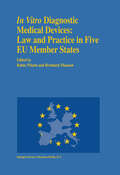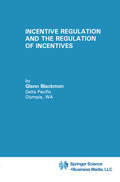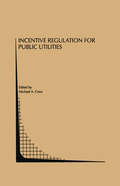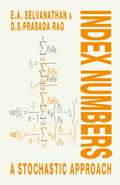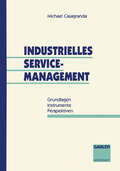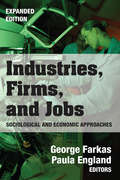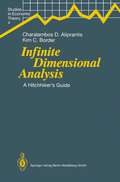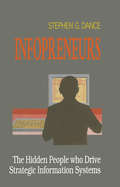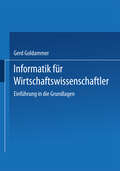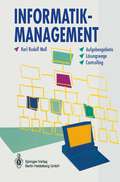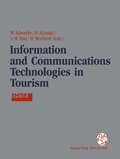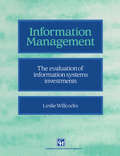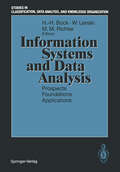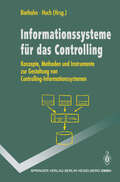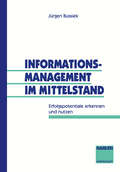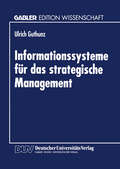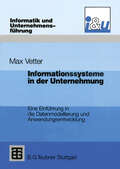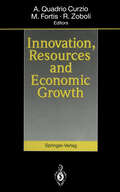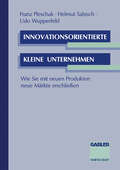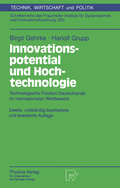- Table View
- List View
In-House-Banking: Neue Erfolgsstrategien im Finanzmanagement internationaler Unternehmen (Schriftenreihe für Kreditwirtschaft und Finanzierung #205)
by Jörg RichtsfeldJörg Richtsfeld durchleuchtet die oft unbekannte, zumindest aber unterschätzte Rolle von internationalen Unternehmen in der traditionell von den Banken betriebenen Finanzintermediation.
In vitro Diagnostic Medical Devices: Law and Practice in Five EU Member States
by Bernhard M. Maassen R. WhaitePreface by T. Morrison, Director-General of the European Diagnostic Manufacturers Association. Contributors: W. Kewenig; G. Forlani, J. Marriage, G. Ulloa This book is based upon a report prepared at the request of the European Commission. Its purpose is to set out the existing laws regulating the development, production, distribution and use of in vitro diagnostic medical devices (IVDMD) in the U.K., Germany, France, Italy and Spain. Each national section has the same structure and covers the same ground in order to enable comparisons. IVDM Devices includes not only reagents, but also technical instruments, or combination of both, for human use. The book is directed towards industry and the regulation is covered with a high degree of specificity. This reference book, completely written in English, is the only comprehensive exposition of the laws of the five countries regarding IVDM Devices available. It is also the most convenient means of comparing those laws. As such, it will be a useful guide to all IVDM Devices manufacturers interested in the European market.
Incentive Regulation and the Regulation of Incentives (Topics in Regulatory Economics and Policy #17)
by Glenn BlackmonThe class is theory of price regulation assumed that the regulator knows the fIrm's costs, the key piece of information that enables regulators to pressure fmns to choose appropriate behaviors. The "regulatory problem" was reduced to a mere pricing problem: the regulator's goal was to align price with marginal cost, subject to the constraint that revenues must cover costs. Elegant and important insights ensued. The most important was that regulation was inevitably a struggle to achieve second-best outcomes. (Ramsey pricing was a splendid example. ) Reality proved harsh to regulatory theory. The fmn's costs are by no means known to the regulator. At best, the regulator may know how much is currently spent to provide services, but hardly what costs would be if the fmn vigorously pursued effIciency. Even if the current cost curve were known to the regulator, technologies change so swiftly that today's costs are a very poor indicator of tomorrow's, and those are the costs that will determine the fIrm's future decisions. With the burgeoning attention to information considerations and game theory in economics, the regulator's problem of eliciting host information about cost has received considerable attention. In most cases, however, it has been in context that are both static and stylized; such analyses rarely capture many of the essential elements of real world regulatory issues. This volume represents a fresh approach. It reflects Glenn Blackmon's twin strengths, a keen analytic mind and important experience in the regulatory arena.
Incentive Regulation for Public Utilities (Topics in Regulatory Economics and Policy #18)
by Michael A. CrewThis book is based on two seminars held at Rutgers on October 22, 1993, and May 6, 1994 entitled `Incentive Regulation for Public Utilities'. These contributions by leading scholars and practitioners represent some of the best new research in public utility economics and include topics such as the theory of incentive regulation, dynamic pricing, transfer pricing, issues in law and economics, pricing priority service, and energy utility resource planning.
Index Numbers: A Stochastic Approach
by D.S. Prasada Rao E.A. Selvanathan'An authoritative survey with exciting new insights of special interest to economists and econometricians who analyse intertemporal and interspatial price relationships.' - Professor Angus Maddison, Groningen University This book presents a comprehensive review of recent developments in the theory and construction of index numbers using the stochastic approach, demonstrating the versatility of this approach in handling various index number problems within a single conceptual framework. It also contains a brief, but complete, review of the existing approaches to index numbers with illustrative numerical examples. The stochastic approach considers the index number problem as a signal extraction problem. The strength and reliability of the signal extracted from price and quantity changes for different commodities depends upon the messages received and the information content of the messages. The most important applications of the new approach are to be found in the context of measuring rate of inflation; fixed and chain base index numbers for temporal comparisons and for spatial intercountry comparisons; the latter generally require special index number formulae that result in transitive and base invariant comparisons.
Industrieforschung in den neuen Bundesländern: Ausgangsbedingungen und Reorganisation (Betriebswirtschaftslehre für Technologie und Innovation #2)
by Anette HilbertAuf der Grundlage theoretischer Überlegungen und empirischer Analysen wird am Beispiel von Forschung und Entwicklung die Transformation von Unternehmen in den neuen Bundesländern untersucht.
Industries, Firms, and Jobs
by George FarkasWhat are the links among industrial structure, segmentation, the internal structure of firms, job characteristics, technology, productivity, labor markets, and product markets? The answers, posited by a distinguished group of sociologists and economists, have gained resonance as the field of economic sociology has grown. In this expanded edition, the editors and their economist colleague, Kevin Lang, explore the theoretical interstices and update the references.Sociologists and economists have responded differently to work within the other discipline. For some sociologists, the typical economic assumption of basic actors engaged in rational action is both unrealistic and objectionable. Other sociologists have not always agreed with everything economists do, they have seen ""rational choice"" as a partially true description of human behavior and as a starting point for sociological theorizing. Among economists, the situation is quite different: most have maintained their basic rational choice model while pushing aggressively into substantive areas previously addressed only by sociologists and political scientists.Industries, Firms, and Jobs is a welcome reassertion of an old tradition of interdisciplinary research. That tradition has recently weakened, largely because of an enormous expansion of the domain of neoclassical economics. The expansion has fed on two scientific developments: human capital theory and contract theory. This book is an invaluable resource for all economists, sociologists, labor specialists, and business professionals.
Industries, Firms, and Jobs: Sociological And Economic Approaches (Springer Studies In Work And Industry Ser.)
by George Farkas Paula EnglandWhat are the links among industrial structure, segmentation, the internal structure of firms, job characteristics, technology, productivity, labor markets, and product markets? The answers, posited by a distinguished group of sociologists and economists, have gained resonance as the field of economic sociology has grown. In this expanded edition, the editors and their economist colleague, Kevin Lang, explore the theoretical interstices and update the references.Sociologists and economists have responded differently to work within the other discipline. For some sociologists, the typical economic assumption of basic actors engaged in rational action is both unrealistic and objectionable. Other sociologists have not always agreed with everything economists do, they have seen ""rational choice"" as a partially true description of human behavior and as a starting point for sociological theorizing. Among economists, the situation is quite different: most have maintained their basic rational choice model while pushing aggressively into substantive areas previously addressed only by sociologists and political scientists.Industries, Firms, and Jobs is a welcome reassertion of an old tradition of interdisciplinary research. That tradition has recently weakened, largely because of an enormous expansion of the domain of neoclassical economics. The expansion has fed on two scientific developments: human capital theory and contract theory. This book is an invaluable resource for all economists, sociologists, labor specialists, and business professionals.
Infinite Dimensional Analysis: A Hitchhiker’s Guide (Studies in Economic Theory #4)
by Charalambos D. Aliprantis Kim C. BorderThis text was born out of an advanced mathematical economics seminar at Caltech in 1989-90. We realized that the typical graduate student in mathematical economics has to be familiar with a vast amount of material that spans several traditional fields in mathematics. Much of the mate rial appears only in esoteric research monographs that are designed for specialists, not for the sort of generalist that our students need be. We hope that in a small way this text will make the material here accessible to a much broader audience. While our motivation is to present and orga nize the analytical foundations underlying modern economics and finance, this is a book of mathematics, not of economics. We mention applications to economics but present very few of them. They are there to convince economists that the material has so me relevance and to let mathematicians know that there are areas of application for these results. We feel that this text could be used for a course in analysis that would benefit math ematicians, engineers, and scientists. Most of the material we present is available elsewhere, but is scattered throughout a variety of sources and occasionally buried in obscurity. Some of our results are original (or more likely, independent rediscoveries). We have included some material that we cannot honestly say is neces sary to understand modern economic theory, but may yet prove useful in future research.
Infopreneurs: The Hidden People Who Drive Strategic Information Systems
by Stephen G. DanceInfopreneurs looks beyond and beneath the hyperbole that currently surrounds Information Technology. Analysing many case studies, the book establishes that none of the more widely publicised methods have managed to create one strategically significant system. The true key lies within people with unique skills and knowledge who can bring IT and business together. Infopreneurs shows managers how to find these individuals in their organisation and how to facilitate their efforts and deploy their unique skills.
Informatik-Management: Aufgabengebiete - Lösungswege - Controlling
by Karl-Rudolf MollDie Bereitstellung effizienter EDV-Systeme ist für viele Großunternehmen wie z.B. Automobilhersteller, Banken und Versicherungen zu einem wichtigen Erfolgsfaktor geworden. Informatik-Management umfaßt alle in diesem Zusammenhang notwendigen operativen Aufgabengebiete wie Entwicklung und Wartung, Schulung und Beratung, Planung, Kontrolle und Stabsaufgaben sowie Betrieb von EDV-Systemen. Schwerpunkt des Buches ist die Darstellung der Management-Aspekte dieser Aufgabengebiete, gegliedert in Aufgaben und Ziele, Erfolgsfaktoren, Lösungswege und deren Konstruktionsprinzipien, Aufbauorganisation und Methoden für wirksames Controlling einschließlich Kennzahlen. Als Randergebnisse werden Informatik-spezifische Arbeitsplätze und deren Anforderungsprofile dargestellt sowie offene Fragen für die Wissenschaft und für Hersteller von Informatik-Produkten aufgezeigt.
Information and Communication in Economics (Recent Economic Thought #32)
by Robert E. BabeAlthough there is a burgeoning interest among economists in `information economics', much of the literature adopts a reductionist conceptualization of information, defining it exclusively as reduction in uncertainty, exploring the implications of imperfect information on markets. This neoclassical treatment obscures major interrelations between economic and communicatory processes. Drawing on a range of distinguished scholarship from both the economic and communication studies disciplines, Information and Communication in Economics explores the implications for economic analysis and our understanding of economic processes of employing a more complete conceptualization of information: information as locus of power; information as evolutionary agent; and media systems as devices for control.
Information and Communications Technologies in Tourism: Proceedings of the International Conference in Innsbruck, Austria, 1994
by Walter Schertler Beat Schmid A. Min Tjoa Hannes WerthnerThe conference ENTER • International Conference on However, the tourist market has several specific characteristics Information and Communications Technologies in Tourism with regard to the use of technological infrastructure: represents a fll'St attempt • On the demand side computerized reservation and general • to provide an international forum for the discussion of the distribution systems (eRS and GDS), managed by big role of telecommunication and information systems in airlines, are well organized and technological pioneers. In tourism, the past they typically focused on the business traveller, • to inform potential users and people concerned with the nowadays they also try to cover the vacation sector. These importance of such technologies and to explain their systems work on a world-wide level and are highly functioning sophisticated. However, it should be added that the • to give an opportunity to the research community, nowadays information provided is rather poor and also selective, scattered into different areas of research, to discuss their which may restrict its usefulness for the promotion of an results on a common platform, and, fmally, entire tourist region. • to intensify the contact and the communication between • Similar to CRSlGDS several tour operators have begun to develop their own systems, although with varying success. researchers, system developers and users.
Information management: The evaluation of information systems investments
by Leslie WillcocksSurvey and study background In an effort to gain some answers on the 1ST capital investment (project selection) decision criteria used in practice, a survey was undertaken in 1990 of 80 American, British, Australian and New Zealand companies. A one-page survey form was used that provided 15 possible 1ST investment criteria, a means of indicating whether they are used or not, the percentage of projects to which each criterion is applied, and an overall ranking in terms of total project value for each criterion. The criteria are shown in Table 2.1. The criteria are categorized into financial, management, and development criteria. They were developed, first, through interviews with some 20 chief information officers (CIOs) in Britain and the United States. These CIOs were questioned on what criteria their organizations use in selecting 1ST investment projects, with the aim of developing a full list of the criteria used in practice. Secondly, the criteria and the form were tested and refined in a pilot study with some 12 companies. The criteria used in the survey and listed in Table 2.1 are primary level criteria.
Information Systems and Data Analysis: Prospects — Foundations — Applications (Studies in Classification, Data Analysis, and Knowledge Organization)
by Hans Hermann Bock Wolfgang Lenski Michael M. RichterProceedings of the 17th Annual Conference of the Gesellschaft für Klassifikation e.V., University of Kaiserslautern, March 3 - 5, 1993
Informations-systeme für das Controlling: Konzepte, Methoden und Instrumente zur Gestaltung von Controlling-Informations-systemen (Springer-Lehrbuch)
by Jörg Biethahn Burkard HuchIn diesem Buch werden Konzepte, Methoden und Instrumente von Informationssystemen für das Controlling dargelegt: Ein ganzheitlich zu konzipierendes Informationssystem ist neben dem Planungs- und Kontrollsystem das wichtigste Instrument des Controlling. Controlling-Informationssysteme werden hinsichtllich Begriff, Funktionen und Struktur aufgezeigt, wobei Informationssysteme selbst Objekt des Controlling sind. Dabei geht es um mehr als die Minimierung der Kosten der Informationsversorgung, wenn sowohl aus operativer als auch aus strategischer Sicht das Informationssystem als Erfolgsfaktor zu optimieren ist. Informationssysteme bedürfen des konzeptionellen Entwurfs und der konkreten Umsetzung. Deshalb werden Datenbanksysteme und -modelle sowie Entwurfsmethoden zur Konzeption von Informationssystemen dargelegt, wobei neue Ansätze - wie objektorientierte Analyse und objektorientiertes Design von Informationssystemen - berücksichtigt werden. Schließlich werden Programmier- und Planungssprachen, Tabellenkalkulationssysteme sowie FIS-Generatoren und KI-Entwicklungsumgebungen als Werkzeuge zur Entwicklung von Controlling-Informationssystemen diskutiert. Diesen konzeptionellen Darlegungen schließen sich Anwenderberichte aus den Häusern Bertelsmann, Krupp, Hoesch und Varta an, um unterschiedliche Entwicklungen aufzuzeigen.
Informationsmanagement im Mittelstand: Erfolgspotentiale erkennen und nutzen
by Jürgen BussiekSchlechte Informationspolitik ist nicht nur das Problem der Großen. Gerade Klein- und Mittelunternehmen können ihre generellen Vorteile mit effizientem Informationsmanagement noch unterstützen und Potentiale für sich gewinnen, die sonst brachliegen würden.
Informationssysteme für das strategische Management: Eine Untersuchung zur theoretischen Fundierung und Gestaltung strategischer Informationssysteme am Beispiel der Kostenrechnung
by Ulrich GuthunzInformationssysteme werden vorwiegend aus der Sicht der technischen Machbarkeit thematisiert. Ulrich Guthunz erarbeitet ein Verständnis strategischer Informationssysteme, das sich am Informationsbedarf orientiert.
Informationssysteme in der Unternehmung: Eine Einführung in die Datenmodellierung und Anwendungsentwicklung (Informatik und Unternehmensführung)
by Max VetterInnovation, Resources and Economic Growth
by Alberto Quadrio Curzio Marco Fortis Roberto ZoboliThe analysis of the interactions between natural resource scarcity, technological innovation and the dynamics of eco- nomic systems has a long-standing tradition in economics. During the 1980s and the early 1990s, a new phase of these interactions initiated under the effects of technological revolution and the problem of the environment. The general concept behind this book is that the issue of natural resou- cesand the environment in relation to economic growth can- not be addressed without due consideration for the effects of technological innovation on thedynamics of economic sy- stems. Technological innovation alone, however, is not a sufficient condition for the sustainability of economic growth. Policies may have a role in solving the internatio- nal distribution problems generated by the non-converging development path of developed and developing countries. In particular, the new international order shaped by the events of the 1980s, made it possible for world management to ad- dress the problems of poverty and the environment.
Innovationsorientierte kleine Unternehmen: Wie Sie mit neuen Produkten neue Märkte erschließen
by Franz Pleschak Helmut Sabisch Udo WupperfeldInnovationspotential und Hochtechnologie: Technologische Position Deutschlands im internationalen Wettbewerb (Technik, Wirtschaft und Politik #8)
by Birgit Gehrke Hariolf GruppDieses Buch stellt umfangreiche empirische Analysen zur Entwicklung der internationalen Wettbewerbsposition in der Bundesrepublik Deutschland (mit neuen Bundesländern) und in anderen Industrieländern dar. Die Untersuchungen erfolgen auf der Grundlage einer von den Autoren erarbeiteten Liste technologieintensiver Waren, die auf dem seit 1988 gültigen internationalen Warenverzeichnis für den Außenhandel beruht. Es werden u.a. angesprochen die Position der Bundesrepublik Deutschland im Preis- und Kostenwettbewerb, die Entwicklung der Welthandelsanteile, die Struktur und die Trends der Außenhandelsergebnisse nach Branchen- und Gütergruppen, die Position im Handel mit forschungsintensiven Waren, die Dynamik und Verflechtung industrieller Forschung und Entwicklung, die Patentieraktivität und Struktur der Patente.

